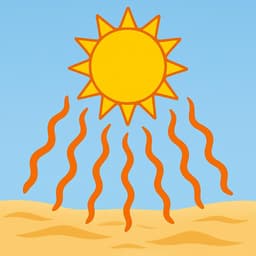It is hot
in SpanishHace calor
/AH-seh kah-LOR/
The standard way to describe hot weather. Literally translates to 'It makes heat.'
💬Other Ways to Say It
Tengo calor
/TEN-goh kah-LOR/
Use this when *you* feel hot (body temperature). Literally 'I have heat.'
Está caliente
/ehs-TAH kah-lee-EHN-teh/
Used for objects, food, or drinks with a high temperature.
¡Qué calor!
/keh kah-LOR/
An exclamation used to complain about the heat.
Pica
/PEE-kah/
Used for 'hot' as in spicy food.
Está picante
/ehs-TAH pee-KAHN-teh/
Another common way to say food is spicy.
Está bochornoso
/ehs-TAH boh-chor-NOH-soh/
Used to describe muggy, humid heat.
Quema
/KEH-mah/
Literally 'it burns.'
🔑Key Words
Key Words to learn:
📊Quick Comparison
Because English uses 'hot' for everything, this table clarifies which Spanish phrase matches which specific context.
| Context | Spanish Phrase | Literal Meaning | Avoid When |
|---|---|---|---|
| Weather / Air | Hace calor | It makes heat | Talking about food or feelings |
| My Body Feeling | Tengo calor | I have heat | Describing objects |
| Food / Objects (Temp) | Está caliente | It is hot | Talking about weather |
| Spicy Food | Pica / Es picante | It stings/bites | Talking about temperature |
📈Difficulty Level
Straightforward vowels and consonants. No tricky rolling R's required for the basic phrases.
Requires switching verbs (Hacer, Tener, Estar) based on context, which is different from English.
High risk of accidental double entendre if you use the wrong verb ('Estoy caliente').
Key Challenges:
- Distinguishing between weather (hacer) and feelings (tener)
- Avoiding the sexual connotation of 'estoy caliente'
💡Examples in Action
Hoy hace mucho calor, vamos a la playa.
It is very hot today, let's go to the beach.
¡Cuidado! El plato está caliente.
Careful! The plate is hot.
¿Podemos abrir una ventana? Tengo calor.
Can we open a window? I am hot.
No puedo comer esto, pica demasiado.
I can't eat this, it's too hot (spicy).
🌍Cultural Context
The 'Estoy Caliente' Trap
This is the most famous mistake English speakers make. While 'I am hot' is innocent in English, saying 'Estoy caliente' in Spanish usually means 'I am horny' or sexually aroused. Always use 'Tengo calor' (I have heat) to talk about your body temperature to avoid awkward giggles!
Weather is Something Nature 'Does'
In Spanish logic, the weather isn't something that 'is'—it's something the atmosphere 'makes' or 'does.' That's why we use the verb *hacer* (to make/do). So, 'hace calor' literally translates to 'it makes heat.'
Spicy vs. Temperature
Spanish makes a clear distinction between thermal heat (*caliente*) and spicy heat (*picante*). If you ask if a salsa is *caliente*, the waiter might check if it has been microwaved. If you want to know if it will burn your mouth with spice, ask '¿Pica?' or '¿Es picante?'
❌ Common Pitfalls
Saying 'Estoy caliente'
Mistake: "Using 'Estoy caliente' to say you feel overheated."
Correction: Tengo calor
Saying 'Es caliente' for weather
Mistake: "Using 'Es caliente' to describe a hot day."
Correction: Hace calor
Confusing spicy and hot
Mistake: "Saying the food is 'caliente' when you mean spicy."
Correction: Está picante / Pica
💡Pro Tips
The 'Touch Test'
If you can touch it and it burns your hand (like coffee or a stove), use *está caliente*. If it's the invisible air around you (weather), use *hace calor*. If it's your own body sweating, use *tengo calor*.
Remembering 'Tengo'
Think of heat as something you possess. You 'have' hunger, you 'have' thirst, and you 'have' heat (*tengo calor*). It's a sensation you are carrying.
🗺️Regional Variations
Mexico
Mexicans often add the suffix '-ón' to emphasize bigness. 'Calorón' means a huge/intense heat.
Spain
Spaniards love colorful idioms. 'Heat of a thousand demons' is a common way to complain about intense summer heat.
Caribbean (Cuba/DR/PR)
In the Caribbean, they sometimes describe the sun itself as 'spicy' (picante) when it feels like it's stinging your skin.
📱Texting & Social Media
Qué calor
Instagram stories or WhatsApp status
Uff q calor hoy 🥵
Oof, what heat today
💬What Comes Next?
Someone complains about the heat
¡Qué calor hace!
It's so hot!
Sí, es insoportable.
Yes, it's unbearable.
Warning someone about hot coffee
Aquí tienes tu café.
Here is your coffee.
¿Está muy caliente?
Is it very hot?
🧠Memory Tricks
Think of 'Heat' and 'Hacer' (to make). Weather MAKES Heat (Hace Calor).
Imagine doing a 'Tango' dance—you get sweaty and 'Have' heat. So when you feel hot, say 'TENGO calor'.
🔄How It Differs from English
English relies heavily on the verb 'to be' (is/am) + adjective for all types of heat. Spanish forces you to categorize the heat: Is it weather? (Use 'Hacer'). Is it a body sensation? (Use 'Tener'). Is it an object's temperature? (Use 'Estar').
False Friends & Common Confusions:
Why it's different: Translating this literally as 'Estoy caliente' changes the meaning to 'I am horny'.
Use instead: Tengo calor (I have heat)
🎯Your Learning Path
➡️ Learn Next:
How to say it is cold
It uses the exact same grammar structures (Hace frío / Tengo frío).
How to order a drink
You'll likely want a cold drink after saying it's hot!
Weather vocabulary
Expand from just 'hot' to sunny, humid, and raining.
✏️Test Your Knowledge
💡 Quick Quiz: It is hot
Question 1 of 3
You are at the beach and the sun is very strong. How do you describe the weather?
Frequently Asked Questions
Why can't I say 'Estoy caliente' for 'I am hot'?
While grammatically correct, 'Estoy caliente' has a strong sexual connotation in most Spanish-speaking countries, meaning 'I'm horny.' It's safer to use 'Tengo calor' (I have heat) for physical temperature.
How do I ask if the food is spicy vs hot temperature?
To ask if it's high temperature, say '¿Está caliente?' To ask if it's spicy, say '¿Pica?' or '¿Es picante?'
Is 'caliente' used for people at all?
Generally, describing a person as 'caliente' is sexual. If you want to say someone is attractive (hot), slang varies by region (e.g., 'guapo/a', 'rico/a'). If you mean they have a fever, say 'Tiene fiebre'.
Do I use 'ser' or 'estar' with caliente?
Almost always 'estar' (está caliente) because temperature is a temporary state. The coffee is hot now, but it will get cold later.
📚Continue Learning Spanish Phrases
Explore More Phrases in These Categories
Find similar phrases to expand your Spanish vocabulary:
Want to Learn More Spanish Phrases?
Browse our complete collection of Spanish phrases organized by situation, from basic greetings to advanced conversations. Perfect for travelers, students, and anyone learning Spanish.
View All Spanish Phrases →


